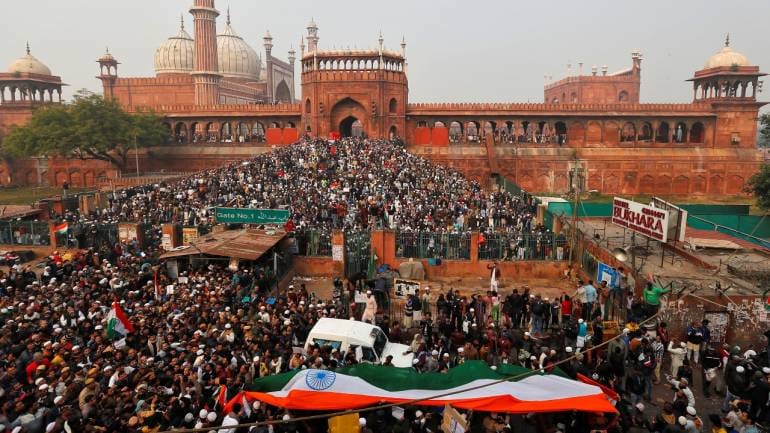Divisive and unconstitutional: The Citizenship Amendment Act, India

By Sasha Patel, History and South Asian Studies
On 4 December 2019, India passed a law granting citizenship to refugees from Pakistan, Bangladesh, and Afghanistan. However, the law explicitly excludes Muslims. The Hindu Nationalist ruling party of India has made yet another move to link religion with citizenship. The Citizenship Amendment Act (CAA) allows migrants from Pakistan, Bangladesh, and Afghanistan to become Indian citizens, only if they are Hindu, Sikh, Parsi, Jain, or Christian. Legal experts and activists oppose the law arguing it violates the secular constitution of India.
The first display of such inter-community unity on this scale since the anti-colonial movement.
At least 30 people have been killed in the violence that ensued the anti-CAA protests, including two 17-year-old minors who were shot by the police in Assam. Protests began after the Bill was introduced into Parliament. The protests spread from North-Eastern states through to India’s major cities. Thousands of arrests and unlawful detainment of protesters continue to take place every day. People from all backgrounds have shown diversity in unity, in what is argued to be the first display of inter-community unity of this scale since the anti-colonial movement.
This Bill comes at a time of increased bureaucratic strategies aiming to exclude minorities who do not fit the Hindu nationalist agenda of the BJP state. The National Register of Citizens (NRC) is described as one of the ‘largest citizenship screening drives in the world’. Citizens of Assam have been forced to prove their roots in the state from before 1971. The NRC primarily targets migrants from neighbouring Bangladesh, meaning predominantly minorities. Muslims and Dalits, are affected most by the Bill. People unable to prove their presence in the state are classified as illegal immigrants and declared stateless. As a result, they either face deportation or imprisonment in inhumane detention centres.
Protests from students at Jamia Millia Ismalia University and Aligarh Muslim University were met with vicious police brutality. Police have forcibly entered campuses and have used tear-gas and batons to seriously injure at least 200 students of the predominantly Muslim student body. Campus violence continued on 5 January 2020. Over 50 masked ABVP (Student wing of the RSS) attackers entered Jawaharlal Nehru University, New Delhi. 39 students and teachers at the university were violently attacked with metal rods, sticks and acid. JNU, a campus synonymous with student activism has constantly been a target of right-wing and pro-government critics.
Sectarian ideologies did not appear in India overnight. India’s ruling Bharatiya Janata Party (BJP), governs on the principles of ‘Hindutva’ (Hindu-ness). Narendra Modi, the current prime minister of India, is a member of the RSS (Rashtriya Swayamsevak Sangh) a far-right extremist Hindu organisation. Inspired by the far-right fascist ideology of early 20th century Europe, the paramilitary group seeks to promote Hindutva ideology which violently excludes Muslims and minorities under the guise of upholding ‘Indian culture.’ PM Modi is said to be complicit in initiating and condoning the anti-Muslim violence, which is estimated to have left 2000 dead. The combined strength of the BJP, RSS and other far-right organisations has enabled an explicitly anti-Muslim, Hindu majoritarian nation riddled with communal divisions and violence both at a local and state level.
The CAA has been enacted against the backdrop of the continued repressive military occupation of Kashmir. Kashmir has been under brutal lockdown since the Indian government revoked Article 370, which guaranteed partial autonomy to the Muslim-majority state. The internet and communication blockade in Kashmir contributes to a vast lack of coverage and information surrounding the effects of the settler-colonial tactics of India on Kashmiris.
One of the most iconic sites of anti-CAA protests is the on-going peaceful protest at Shaheen Bagh, New Delhi. The protestors, predominantly comprising of Muslim women, began the sit-in on 15 December 2019. Shaheen Bagh has been continuously occupied for over a month. The protest is not only against the CAA and NRC but also in condemnation of the police brutality on students at Jamia Millia Islamia University.
Anti-CAA agitation in India has been met with solidarity protests from all around the world. From New York to Amsterdam, and London to Tokyo, iconic songs of transnational protest such as Faiz’s ‘Hum Dekhenge’ or slogans of ‘Inquilab Zindabad’ have become synonymous with opposition to majoritarian rule both in and outside of India. A recent sit-in on 8 January, organised by SOAS India Society and South Asian Students Against Fascism UK in solidarity with protestors and the nationwide strike, saw the attendance of nearly 200 students and members of the diaspora. Speeches from academics and activists detailing the presence of Hindutva in diaspora politics, Dalit struggles in the UK to the relevance of Bhagat Singh today, were made throughout the 12-hour sit-in.
The CAA, NRC, and settler-colonial occupation of Kashmir and the North-Eastern states all demonstrate the continued attempts by the Indian state to turn India into a Hindu nation that is vehemently anti-Muslim, anti-Dalit and anti-minority, rooted in Brahmanical patriarchy. The implementation of the CAA and NRC are a direct attack on the secular constitution of India. Despite the diversity of protestors, the Indian state continues to violently crack-down on any form of dissent. How can we celebrate ‘Independence’ when colonial tactics of divide and rule continue to be propagated by majoritarian regimes? What is the future of minorities in India when Modi continues to be supported by the likes of Trump, Netanyahu and Bolsonaro?



